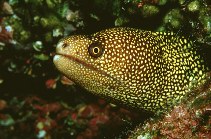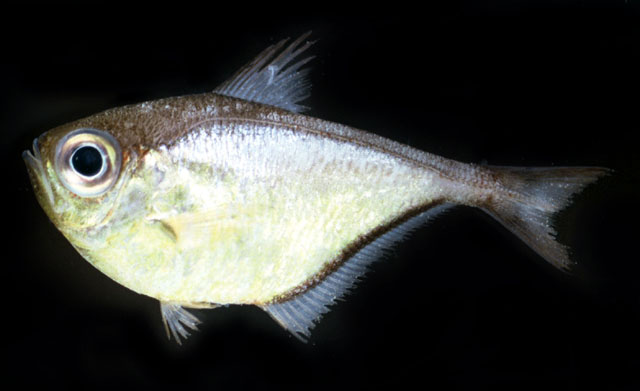The four main fish wells, each about 3x3x10 feet, have been secured as well, along with the six other tanks carrying our precious cargo. A pumping system will circulate sea water through all of the tanks until we get within an hour or so of Miami. From that point on, the water quality begins to deteriorate (Nice to be back home, huh?) and cannot be used. About ten 50-gallon barrels have been filled with fresh seawater as well. That water will be used to fill the plastic bags within which the animals will be shipped back to Boston.
So, how did we do? 377 fishes, 58 different species; 153 invertebrates, 44 species. We feel pretty darn good about this collection. In fact, everyone is extremely pleased! Among the wonderful animals we'll be loading on to airplanes for shipment back to Boston tomorrow are:
-
 4 indigo hamlets (Hypoplectrus indigo at right) These fish have not been exhibited for several years at the Aquarium. Somewhat rare in the Bahamas, the fish we caught were first spotted by Captain John on a morning dive at Whale Cay, then retrieved later the same day. We all believe, of course, that the four fish were precisely the same fish that the Captain had seen four hours earlier.
4 indigo hamlets (Hypoplectrus indigo at right) These fish have not been exhibited for several years at the Aquarium. Somewhat rare in the Bahamas, the fish we caught were first spotted by Captain John on a morning dive at Whale Cay, then retrieved later the same day. We all believe, of course, that the four fish were precisely the same fish that the Captain had seen four hours earlier. -
 Two moray eels: a goldentail (Gymnothorax milaris at right) and a purplemouth (Gymnothorax vicinus). Both are about 12-14 inches in length. The purplemouth moray will be new to the Giant Ocean Tank in Boston. It was caught by our soon-to-be-married couple from the Netherlands, Marcelle and Bas. If they are as determined in their relationship as they were chasing fish, we have no doubt they will have a long happy life together.
Two moray eels: a goldentail (Gymnothorax milaris at right) and a purplemouth (Gymnothorax vicinus). Both are about 12-14 inches in length. The purplemouth moray will be new to the Giant Ocean Tank in Boston. It was caught by our soon-to-be-married couple from the Netherlands, Marcelle and Bas. If they are as determined in their relationship as they were chasing fish, we have no doubt they will have a long happy life together.
-
Three trumpetfish (Aulostomus maculates), which will complement the one trumpet now on exhibit in the GOT. The NEAq aquarists on board say this new quartet will hang well together--literally straight up and down -- delighting visitors with their ability to respond to visual targets (a small plastic green cup) during feeding time (shown at right).
-
 One cowfish, a juvenile, that we can't yet identify definitively. He's got horns, so we know he's belongs to the genus Lactophyrs. He's about the size of a quarter, now, and ultimately will grow to about a foot. He's destined for one of our smaller tanks in the Tropical Gallery until he's man enough for the GOT.
One cowfish, a juvenile, that we can't yet identify definitively. He's got horns, so we know he's belongs to the genus Lactophyrs. He's about the size of a quarter, now, and ultimately will grow to about a foot. He's destined for one of our smaller tanks in the Tropical Gallery until he's man enough for the GOT. -
 One yellow stingray (Urobatis jamaicensis shown at right) headed for the new temporary "shark and ray touch tank" we'll be installing on the east side of the Aquarium this summer. There, he will be joined by coral catsharks and cownose rays already in holding tanks back in Boston. We were careful not to take a female also seen off Bimini because she was pregnant with pups. Kids visiting the Aquarium will love this new touchtank.
One yellow stingray (Urobatis jamaicensis shown at right) headed for the new temporary "shark and ray touch tank" we'll be installing on the east side of the Aquarium this summer. There, he will be joined by coral catsharks and cownose rays already in holding tanks back in Boston. We were careful not to take a female also seen off Bimini because she was pregnant with pups. Kids visiting the Aquarium will love this new touchtank. -
 Two basket stars (Astrophyton muricatum), fascinating invertebrates with intricate branching arms that fold up during the day and open at night, when they are used to filter plankton. This species can often be found on fan coral. We're not sure yet where they will be found in our galleries in Boston, you will have to come on down to find out!
Two basket stars (Astrophyton muricatum), fascinating invertebrates with intricate branching arms that fold up during the day and open at night, when they are used to filter plankton. This species can often be found on fan coral. We're not sure yet where they will be found in our galleries in Boston, you will have to come on down to find out! Five red snapping shrimp (Alpheus armatus), each about an inch long (how the other divers found these on the bottom beats me! As a new diver, I could barely find the bottom sometimes.) This species makes a unique clicking sound. Like the other creatures mentioned above, you can find them in the ocean in the Bahamas or the beautiful exhibits at the New England Aquarium in Boston.
4:00 PM. Hey, land ho! There's the Miami skyline in the distance. And did I mention the rough seas? The passage actually turned out to be rather tranquil, with long and peaceful naps enjoyed by all. See you in Boston!









